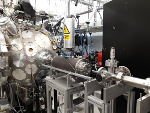| Version 1 (modified by , 7 years ago) ( diff ) |
|---|
Investigation of feature recognition in clinical CT images as a step towards adaptive radiotherapy
Summary
The delivery of radiotherapy (RT) using X-ray and proton beams relies on the determination of the position of the tumour in relation to healthy tissues and other sensitive organs. To do this X-ray computed tomography (CT) is used. Radiotherapy is usually delivered over a period of weeks. During this time the patient may gain or lose weight. This means that the original treatment-planning CT may become less accurate as the treatment progresses.
In addition to such long-term changes in patient geometry, the position of tumours in relation to healthy tissue and organs at risk varies as a result of breathing, peristalsis, etc. These movements are a major challenge in radiotherapy. Image-guided radiotherapy (IGRT) uses cone-beam CT to detect tumour position immediately prior to treatment, allowing the adaptation of RT if the target position differs from that assumed in planning. Present systems are manually operated, slow and have limited precision. One of the goals of the research programme of the Centre for the Clinical Application of Particles that has recently been established at Imperial is to develop techniques to enhance the delivery of RT. As part of this programme, we seek to develop the techniques required to automate the IGRT process.
The first step in the automation of IGRT is the development of algorithms capable of recognising key features in the CT images. The goal of this project, to take the first steps in the development of the requisite algorithms, will be carried out in a number of steps. The first step will be to review a library of typical CT images of healthy organs alongside CT images that contain a tumour. The review of the images will allow a specification for the feature-recognition algorithm to be developed. The next step will be to develop an algorithm, or a sequence of algorithms, that is capable of isolating the tumour position within the image. Once these steps have been executed, the algorithms will be tested on a second library images. Extensions to the algorithm to identify organs at risk can then be developed if time allows.
Suggested reading material
The Essential Physics of Medical Imaging, 2nd Edition, J. T. Bushberg, J. A. Seibert, E. M. Leidholt and J. M. Boone (published by Lippincott, Williams and Wilkins)
